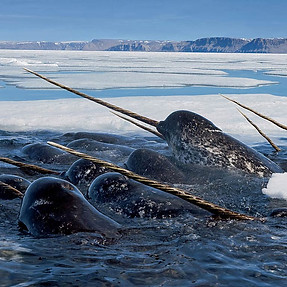
Approximately 10% of the world is covered in Ice and is mainly found in the Greenland and Antartica Ice sheets.
These can include Glaciers which are huge packs of Ice that move very slowly from higher altitudes. They can travel an average of 1 metre per day with some known to speed down the mountain side at up to 25 metres per day!
Due to lower air pressure and temperatures snow and ice are mainly found at higher altitudes where the air is thinner, hence why tall Mountains such as Mt Everest are snow-capped. Snow coverings especially in the North and South poles help to regulate the Earth's temperature due to its white reflective surface bouncing the suns rays away from the surface.
DID YOU KNOW
The icy continent of Antarctica is actually classified as a desert due to its lack of rain.


Mountains are the tallest natural wonders in the World, but just how did they come to be so big?
Underneath the earth's surface the world is broken up into plates, which are huge pieces of land that everything sits on.
Many millions of years ago some of these plates crashed into each other. When they did they pushed the earths surface up and created Mountains.
There are 5 different types of Mountain Ranges:
Dome - These are huge hills that are curved on the top with no peak. They are not as big as the others below.
Plateau - These have long flat tops with no peaks.
Fold - Here many mountains stand close together one after another, with multiple peaks.
Block - These are the biggest kind and have single peaks that reach high up into the clouds.
Volcanoes - These mountains are still alive and being pushed by the plates causing lava to flow out of the top!
FAMOUS MOUNTAINS OF THE WORLD
K2 - 28,251 ft
Kilimanjaro - 19,340 ft
Matterhorn - 14,690 ft
Mont Blanc - 15,780 ft
Mount Cook - 12,218 ft
Mt Everest - 29,030 ft
Mt Fuji - 12,390 ft
Mount Olympus - 9,570 ft
Table Mountain - 3,558 ft
ACTIVITY
1. Look up one of the famous mountains above.
2. Take a peek at a picture of it and see if you can work out what type of mountain range it comes from using the descriptions above the map.

MOUNTAIN RANGES OF THE WORLD
FAMOUS MOUNTAINS RANGES OF THE WORLD
Andes
Alps
Himalayas
Rocky Mountains
Appalachian Mountains
Atlas Mountains

WHO LIVES AMONGST THE ICE?
Hi i'm part of a culture and community called Inuits. We are indigenous people that live in the Arctic Circle in the North of Canada and Greenland.
We are famous for being builders of Igloo's. These structures are made from carved blocks of ice, piled high in the shape of a dome. It keeps us warm and sheltered from the harsh arctic winds and temperatures.
Igloo's can be a toasty 15C inside when it's a freezing -45C outside! Once inside the amount of people that gather in them they generate enough heat to act as a small heater which melts and fuses the ice blocks together, making it even stronger.
You can find out more about Inuits and other indigenous people HERE.





Polar Bear
Type of animal - Mammal
Maximum Length - 2.8m
Region - Arctic Circle
Diet - Seals
Snowy Owl
Type of animal - Bird
Wingspan - 1.6m
Region - Arctic Circle
Diet - Lemmings and fish
Harp Seal
Type of animal - Mammal
Maximum Length - 1.7m
Region - Arctic Circle
Diet - Fish

Arctic Fox
Type of animal - Mammal
Maximum Length - 1.1m
Region - Arctic Circle
Diet - Lemmings

Narwhal
Type of animal - Mammal
Maximum Length - 5m
Region - Arctic Circle
Diet - Fish

Muskox
Type of animal - Mammal
Maximum Length - 2.5m
Region - Arctic Circle
Diet - Grasses

PSST... DID YOU KNOW?
The Arctic Circle around the North Pole is entirely made from ice!
There is no land at all it's all thick ice made from the frozen Arctic Ocean. This ice can be up 5 metres thick, so safe enough to walk on if you wrap up warm.
SNOW & ICE ON FILM
Let's learn about the world's Mountains and Icy environments.
Scroll down or click on the links below to learn more about the highest peaks and coldest places.



